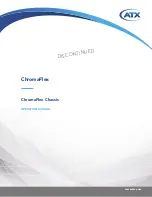
1-8
Stinger® MS+ Getting Started Guide
Preparing for the Installation
Verifying the hardware configuration
Note
Stinger units can also be equipped with the specialized IP2000 control module.
Information specific to the IP2000 control module is found in the
Stinger IP2000
Configuration Guide
.
Table 1-2 shows the features provided by the revision 2 and 2.1 Stinger control
modules.
Note
The
version
command displays information about the version and type of
control module installed in a Stinger unit. For details, see “Verifying software and
control module versions” on page 4-5.
Control module support
TAOS 9.4-185.2 introduced support for a Model E version of the control module
(STGR-CM-A2). The Model E control module utilizes enhanced chip-sets and
replaces the older Model A control module. The Model E control module is identified
in TAOS as hardware revision 2.1. The Stinger Model A control module
(STGR-CM-A), introduced with TAOS 9.1-142.1, is also supported by the current
version of TAOS.
Control module interfaces
Figure 1-6 shows the location of the modem port, Ethernet port, serial diagnostic
port, alarm input port, and Personal Computer Memory Card International
Association (PCMCIA) slots on a model B control module.
Note
See the
Stinger IP2000 Configuration Guide
for information about the specialized
interfaces on the IP2000 control module.
Table 1-2. Control module models and features
STGR-
CM-A
STGR-
CM-A2
STGR-
CM-B
STGR-
CM-C
Features
Yes
Yes
Yes
Yes
Accepts seven alarm inputs from external
devices to centralize alarm reporting.
Yes
Yes
Yes
Yes
Memory increased to 128Mb of internal
synchronous dynamic RAM (SDRAM) and
32Mb of nonvolatile RAM on a PCMCIA
card.
No
No
Yes
Yes
Contains an internal 56Kbps modem for
dial-in remote administration.
No
No
No
Yes
Contains an internal Stratum 3 clock.
















































